1. Introduction
Charles Darwin’s Origin of Species (1859) opens with these words:
When on board H.M.S. Beagle as naturalist, I was much struck with certain facts in the distribution of the inhabitants of South America, and in the geological relations of the present to the past inhabitants of that continent. These facts seemed to me to throw some light on the origin of species…
Today, we refer to the study of the geographic distribution of species as biogeography. Both Darwin and Alfred Russell Wallace (the co-discoverer of the idea of natural selection) made important early contributions to this field. Not surprisingly, biogeography also provides evidence for evolution.
In what follows, I’m going to closely follow an argument laid out by Jerry Coyne in his book Why Evolution is True, which I strongly recommend to anyone interested in learning more about the evidence for evolution.
2. Biogeography and Convergent Evolution
Take a look at the following plants.
[qwiz summary=”false” repeat_incorrect=”false” qrecord_id=”sciencemusicvideosMeister1961-Evidence for Evo: cacti and euphorbs”]
[h] Mystery Succulent
[q] Plant 1
[q] Plant 2
[q] Plant 3
[q] Most people would categorize the plants in the previous slides (one of which is shown below) into which plant family? [hangman]
[c]IENhY3R1cw==[Qq]
[f]IFJpZ2h0JiM4MjMwO1RoYXQmIzgyMTc7cyBpbmRlZWQgd2hhdCBtb3N0IHBlb3BsZSB3b3VsZCBkbywgYnV0IHRoZXkmIzgyMTc7cmUgYWxsIHdyb25nLiBUaGVzZSBwbGFudHMgYXJlIGFsbCA=ZXVwaG9yYnM=LiBUaGV5JiM4MjE3O3JlIHN1cGVyZmljaWFsbHkgbGlrZSBjYWN0aSwgYnV0IA==[Qq]not closely related to them. Unlike cacti, which (with one exception), are limited to North and South America, euphorbs live in the deserts of Africa, Asia, and the driest parts of Europe.
[q]Study the pictures below of a cactus (left) and a euphorb) right
| Barrel Cactus, Arizona, USA | Euphorbia grandialata, Canary Islands, Spain |
Read below to see how this relates to evolution.
[q labels=”top”]Cacti and euphorbs are both ___________ to living in deserts. To avoid __________ loss, their ___________ have become reduced to spines. Their ________ are thick,coated with wax, and adapted for water_________.
[l]leaves
[fx] No. Please try again.
[f*] Excellent!
[l]adapted
[fx] No. Please try again.
[f*] Good!
[l]stems
[fx] No, that’s not correct. Please try again.
[f*] Good!
[l]storage
[fx] No, that’s not correct. Please try again.
[f*] Great!
[l]water
[fx] No, that’s not correct. Please try again.
[f*] Good!
[q]But cacti and euphorbs evolved these adaptations separately. In other words, as plant species go, they’re not closely [hangman] to one another. They did not inherit their adaptations from a common [hangman].
[c]cmVsYXRlZA==[Qq]
[c]YW5jZXN0b3I=[Qq]
[x]Convergent evolution is the process by which similar selective pressures act upon distantly related lineages, resulting in superficially similar adaptations in the descendants. To converge, means to come together, as in “lines converging.” But in terms of convergent evolution, the coming together is superficial.
Read on to see how convergent evolution supports evolutionary theory.
[/qwiz]
Why do distant areas with similar climates support unrelated species that, like cacti and euphorbs, have similar adaptations? Because of descent with modification. Over the course of evolution, one lineage of plants became adapted to the deserts of North and South America. This lineage gave rise to the cacti. Another lineage became adapted to the deserts of Eurasia, Africa, and Australia. This lineage gave rise to the euphorbs. If you look superficially, they’re similar. But a deeper look (one that includes, for example, looking at their DNA), reveals that these species aren’t closely related.
You can think of convergent evolution as being the counterpart of adaptive radiation. In adaptive radiation, one ancestral species diverges into several descendant species, each with distinct adaptations. In convergent evolution, unrelated lineages converge into a superficially similar forms.
An example of convergent evolution occurring in an entire group of animals involves the marsupial mammals of Australia and the placental mammals of North and South America. Study the pairs of animals in the diagram below.
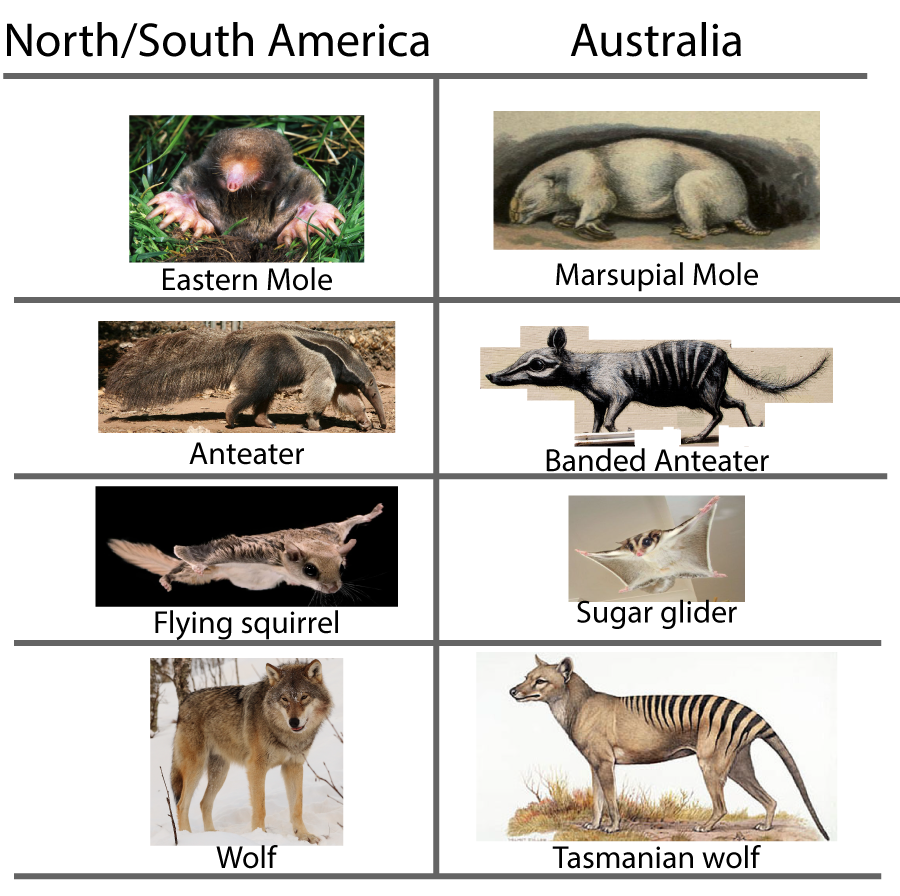
The marsupials are the pouched mammals (think of kangaroos). Their young are born in an extremely immature state. After being born, the young drag themselves to their mother’s pouch, latch onto her nipple, and remain there until they they can survive outside of the pouch. The pouch is called a marsupium: hence the name, marsupials.
Placental mammals —like primates (our group), rodents, carnivores, elephants, bats, and so on — are born in a much more mature state.
To understand Marsupial evolution, we need to see how the globe has changed over the past hundreds of millions of years. These changes are referred to as continental drift, and explained by the geological theory of plate tectonics (which is outside the scope of this course. If you’re interested, read about it on Wikipedia).
Take a moment to study the series of maps below. Pay attention to the times and the position of the continents.
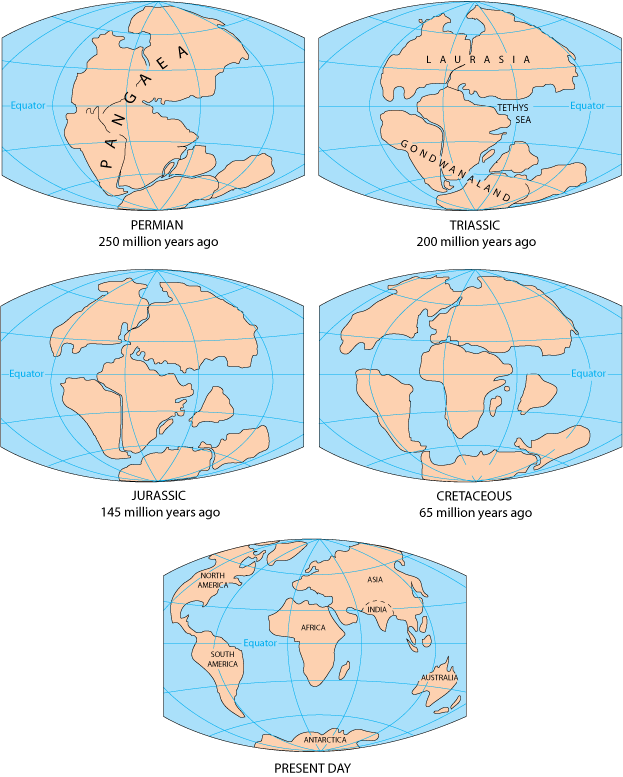
The Marsupials first emerged in the Americas during the time of the dinosaurs, about 125 million years ago. At that time, the continents were arranged in a way that’s intermediate between the Jurassic and Cretaceous maps above. At that time South America had recently disconnected from Africa, and land connected South America, Antarctica, and Australia. Antarctica, at that time, was not as cold as it is today. Marsupials spread from the Americas, through Antarctica, and arrived in Australia about 60 million years ago.
Placentals emerged after the marsupials: about 65 million years ago, close to the time when dinosaurs became extinct. The extinction of the dinosaurs led to a widespread diversification of placental mammals. Though it’s not clear why, it looks like placentals outcompeted the marsupials in many parts of the world, where many marsupials became extinct. That’s why, for example, almost all of the mammals of North America are placentals: the opossum is a notable exception.
But before placentals could make it to Australia, that continent had separated from the rest of the continents. Except for bats, Australia remained free of placental mammals: a marsupial safe-haven.
So we have two distantly-related groups of mammals. In each region, similar ecological niches were available. Into each of these niches, evolution unfolded in a parallel way. There was a niche for a burrowing mammal that could prey on worms and other organisms in the soil. Into that niche evolved the placental Eastern mole in the Americas, and the marsupial mole in Australia. Into the ant-eating niche evolved the placental South American anteater, and the Australian marsupial banded anteater, also called the numbat. Into the tree-living, small gliding niche evolved the placental flying squirrel in the Americas, and the marsupial sugar glider in Australia. And into a top carnivore niche evolved the wolf in the Americas, and the Tasmanian wolf (extinct since the 1930s) in Australia.
There’s a side note to this story that serves as additional evidence for evolution. As stated above, based on the fossil record, it was known that marsupials evolved in the Americas and migrated through Antarctica to Australia. So, one could predict that fossils of marsupial mammals should be found in Antarctica. In 1982, a team of American scientists found exactly that: fossils of rat-sized marsupials (identified by their distinctive teeth and bones) that dated to about 40 million years ago. These weren’t the ancestors of Australia’s marsupial mammals, because Australia had already broken off from Antarctica at that point. But they confirm that Antarctica had once been home to marsupials.
Finally, it’s worth noting that while we can explain the biogeographical distribution of species by referring to continental drift, fossil evidence was an important clue that set the stage for the discovery of continental drift and the underlying theory of plate tectonics. By the early 1900s, geologists had mapped the location of a variety of fossils of what seemed, based on morphology, to be the same species. But the distances separating these fossil finds were vast, often crossing oceans. Look, for example at the presence of the extinct fern Glossopteris in South America, Africa, India, Australia, and Antarctica. Or the presence of the extinct reptile Lystrosaurus in Antarctica, India and Africa.
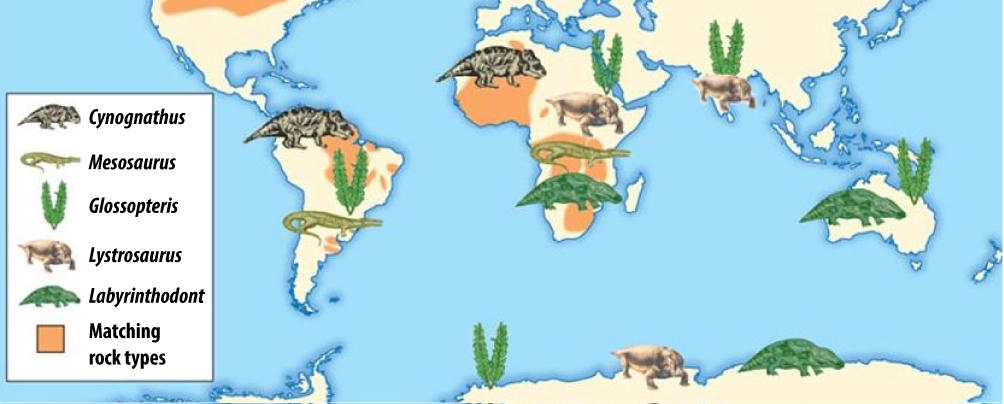
This distribution makes sense if the continents, rather than being locked in their current positions, actually moved. This idea was proposed by Albert Wegener in 1912. His solution to the puzzle is below.
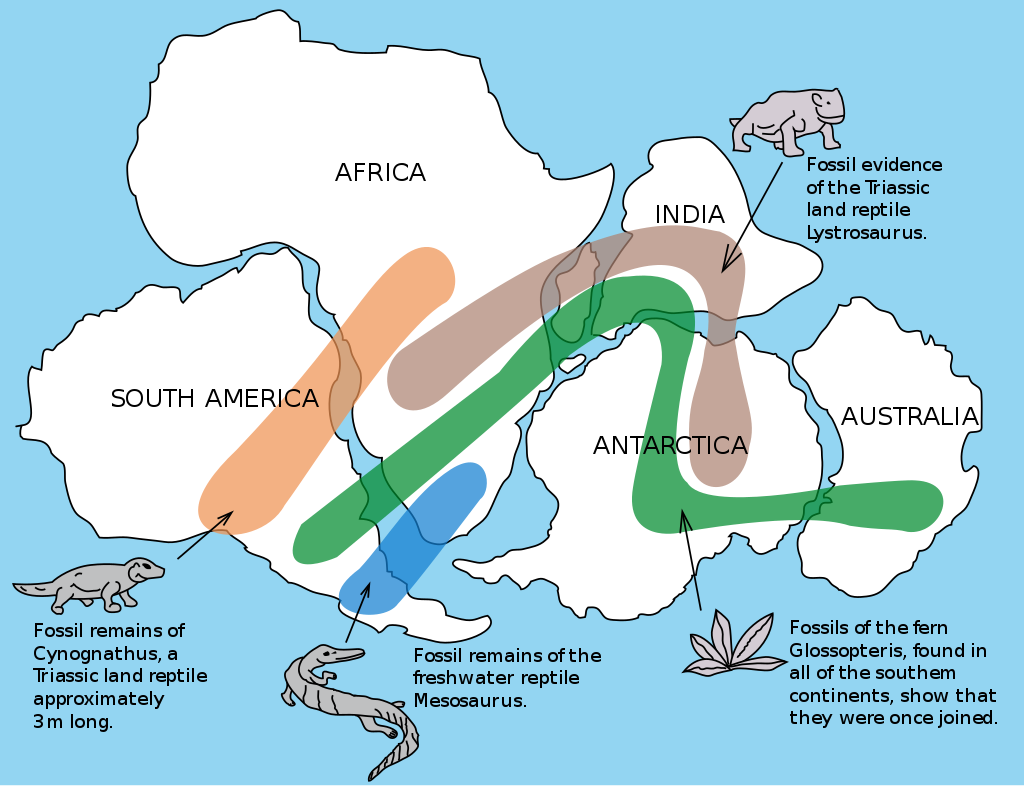
Because Wegener lacked a mechanism to explain the movement of the continents, his idea of continental drift was widely rejected during his lifetime. However, it was revived and accepted when the theory of plate tectonics arose in the 1950s and 1960s.
3. Convergent Evolution happens when similar selective pressures elicit similar adaptations in distantly related groups
Convergent evolution can be rooted in biogeography, as with the marsupial and placental mammals discussed above. But that’s just one instance of a more general phenomenon of convergent evolution. Look at the three organisms below.
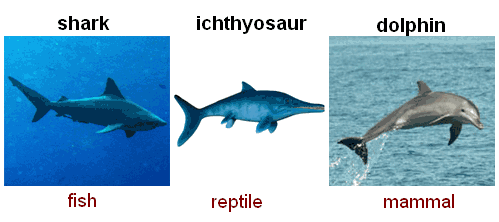
An ichthyosaur is an extinct marine reptile that perished at the same time as the dinosaurs became extinct, 65 million years ago. But from its fossils, we know that it had a hydrodynamic (streamlined) shape, similar to that found in sharks and dolphins. The similar phenotype shared by all three animals is not from common ancestry. It’s an example of convergent evolution. In each group of animals, similar selective pressures resulted in similar adaptations.
The adjective used to describe the similar phenotypes that result from convergent evolution is analogous. It’s important to keep the terms analogous and homologous (and the related nouns analogy and homology) distinct. Practice making this distinction in the questions below.
[qwiz qrecord_id=”sciencemusicvideosMeister1961-Evidence for evo: homology or analogy”]
[h] homology or analogy
[q multiple_choice=”true”] The wing of a butterfly and the wing of a bat.
[c]IGhvbW9sb2d5[Qq]
[f]IE5vLiBUaGVzZSB3aW5ncyBhcmUgYm90aCBhZGFwdGF0aW9ucyBmb3IgZmx5aW5nLiBCdXQgdGhleSBkaWRuJiM4MjE3O3QgcmVzdWx0IGZyb20gaW5oZXJpdGFuY2UgZnJvbSBhIGNvbW1vbiBhbmNlc3Rvci4=[Qq]
[c]IEFuYW xvZ3k=[Qq]
[f]IEV4Y2VsbGVudC4gVGhlc2Ugd2luZ3MgYXJlIHRoZSByZXN1bHQgb2YgY29udmVyZ2VudCBldm9sdXRpb24sIG5vdCBjb21tb24gYW5jZXN0cnkuIFRoZXkmIzgyMTc7cmUgYW5hbG9nb3VzIChub3QgaG9tb2xvZ291cyku[Qq]
[q multiple_choice=”true”] The beak of a platypus (a mammal) and the beak of a duck (a bird).
[c]IGhvbW9sb2d5[Qq]
[f]IE5vLiBUaGVzZSBiZWFrcyBhcmUgYm90aCBhZGFwdGF0aW9ucyBmb3IgZWF0aW5nLiBCdXQgdGhleSBkaWRuJiM4MjE3O3QgcmVzdWx0IGZyb20gaW5oZXJpdGFuY2UgZnJvbSBhIGNvbW1vbiBhbmNlc3Rvci4=[Qq]
[c]IEFuYW xvZ3k=[Qq]
[f]IE5pY2Ugam9iLiBUaGVzZSBiZWFrcyBhcmUgdGhlIHJlc3VsdCBvZiBjb252ZXJnZW50IGV2b2x1dGlvbiwgbm90IGNvbW1vbiBhbmNlc3RyeS4gVGhleSYjODIxNztyZSBhbmFsb2dvdXMgKG5vdCBob21vbG9nb3VzKS4=[Qq]
[q multiple_choice=”true”] The forearm of a human being and the flipper of a dolphin.
[c]IGhvbW 9sb2d5[Qq]
[f]IEZhYnVsb3VzLiBUaGVzZSBmb3JlYXJtcyBhcmUgYm90aCB2YXJpYXRpb25zIG9uIGEgYmFzaWMgdmVydGVicmF0ZSBmb3JlYXJtIHRoZW1lLiBUaGUgc2ltaWxhcml0eSBpbiB0aGUgdW5kZXJseWluZyBib25lcyBzaG93cyBldmlkZW5jZSBvZiBjb21tb24gYW5jZXN0cnkuIEVhY2ggZm9yZWFybSBoYXMgYmVlbiBtb2RpZmllZCBhcyBhbiBhZGFwdGF0aW9uIGZvciBhIHNwZWNpZmljIGVudmlyb25tZW50LiBUaGF0IG1ha2VzIHRoZW0gaG9tb2xvZ291cy4=[Qq]
[c]IEFuYWxvZ3k=[Qq]
[f]IE5vLiBBbmFsb2dvdXMgc3RydWN0dXJlcyByZXN1bHQgZnJvbSBjb252ZXJnZW50IGV2b2x1dGlvbi4gVGhleSYjODIxNztyZSBhbmFsb2dvdXMgaW4gdGVybXMgb2YgdGhlaXIgZnVuY3Rpb24uIEluIHRoaXMgY2FzZSwgdGhlIGZ1bmN0aW9uIG9mIHRoZSBmb3JlbGltYiBpcyBxdWl0ZSBkaWZmZXJlbnQu[Qq]
[q multiple_choice=”true”] WARNING: Think carefully! The forelimb of a bird and a bat.
[c]IGhvbW 9sb2d5[Qq]
[f]IEZhYnVsb3VzLiBJZiB5b3UgYXJlIHRoaW5raW5nIG9mIHRoZXNlIGFzIA==Zm9yZWxpbWJzIA==KGFzIG9wcG9zZWQgdG8=IGFzIHdpbmdzKQ==IHRoZW4gdGhleSYjODIxNztyZSBib3RoIHZhcmlhdGlvbnMgb24gYSBiYXNpYyB2ZXJ0ZWJyYXRlIGZvcmVhcm0gdGhlbWUuIFRoZSBzaW1pbGFyaXR5IGluIHRoZSB1bmRlcmx5aW5nIGJvbmVzIHNob3cgZXZpZGVuY2Ugb2YgY29tbW9uIGFuY2VzdHJ5Lg==[Qq]
[c]IEFuYWxvZ3k=[Qq]
[f]IE5vLiBUaGlzIGlzIHZlcnkgdHJpY2t5LiBJZiB0aGUgcXVlc3Rpb24gd2FzIGFib3V0IFdJTkdTLCB5b3UmIzgyMTc7ZCBiZSByaWdodCwgYmVjYXVzZSB0aGUgdHdvIGdyb3VwcyAoYmlyZHMgYW5kIG1hbW1hbHMpIGNvbnZlcmdlZCBvbiB0aGUgc2FtZSBzb2x1dGlvbi4gQnV0IHRoZSBxdWVzdGlvbiBpcyBhYm91dCA=Zm9yZWxpbWJzLiBBcyBmb3JlbGltYnMgZ28sIHRoZXNlIHN0cnVjdHVyZXMgYXJlIGhvbW9sb2dvdXM6IHNhbWUgYm9uZXM7IHNhbWUgZW1icnlvbmljIHRpc3N1ZTsgaW5oZXJpdGVkIGZyb20gYSBjb21tb24gYW5jZXN0b3Iu[Qq]
[q multiple_choice=”true”] WARNING: Think carefully! The wing of a bird and the wing of a bat.
[c]IGhvbW9sb2d5[Qq]
[f]IE5vLiBJZiB5b3UgYXJlIHRoaW5raW5nIG9mIHRoZXNlIGFzIFdJTkdTLCB0aGVzZSBhcmUgbm90IHNoYXJlZCBmZWF0dXJlcyB0aGF0IHdlcmUgaW5oZXJpdGVkIGZyb20gYSBjb21tb24gYW5jZXN0b3IuIFRoZSBhbmNlc3RvcnMgb2YgYmF0cyB3ZXJlIHJvZGVudC1saWtlIG1hbW1hbHMgd2hvIGV2b2x2ZWQgaW50byBhIGZseWluZyBuaWNoZS4gVGhlIGFuY2VzdG9ycyBvZiBiaXJkcyB3ZXJlIHNtYWxsIGRpbm9zYXVycyB3aG8gc2ltaWxhcmx5IGV2b2x2ZWQgaW50byBhIGZseWluZyBuaWNoZS4gQnV0IHRoZXkgZGlkIHRoaXMgaW5kZXBlbmRlbnRseS4gVGhlIHdpbmdzIGFyZSBhbmFsb2dvdXMsIG5vdCBob21vbG9nb3Vz[Qq]
[c]IEFuYW xvZ3k=[Qq]
[f]IFdvdyEgVGhpcyBpcyB2ZXJ5IHRyaWNreSwgYnV0IHlvdSBzdGlsbCBnb3QgaXQgcmlnaHQhIFR3byBncm91cHMgKGJpcmRzIGFuZCBtYW1tYWxzKSBjb252ZXJnZWQgb24gdGhlIHNhbWUgc29sdXRpb24uIFRoYXQgbWFrZXMgdGhlbSBhbmFsb2dvdXMgc3RydWN0dXJlcywgcmVzdWx0aW5nIGZyb20gY29udmVyZ2VudCBldm9sdXRpb24u[Qq]
[q]This diagram is saying that the streamlined form of sharks, dolphins and ichthyosaurs is an [hangman] feature. That’s because this phenotype evolved from [hangman] evolution, and not from a common [hangman].
[c]YW5hbG9nb3Vz[Qq]
[c]Y29udmVyZ2VudA==[Qq]
[c]YW5jZXN0b3I=[Qq]
[/qwiz]
4. More Biogeography: Life on Oceanic Islands
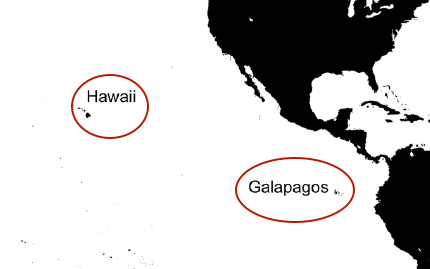
Oceanic islands are the small, usually volcanic islands that are located at a considerable distance away from the nearest continent. Think of islands like the Galapagos (1000 kilometers away from Ecuador), or the Hawaiian islands (2500 kilometers away from the west coast of North America).
Biologically, these islands have a few things in common.
- They are missing many types of animals and plants found on continents or on large continental islands. Examples of continental islands are the British isles, Taiwan, Long Island, etc. These islands are both large and close to the nearest continent.
- On all oceanic islands, the same types of organisms are missing: amphibians, freshwater fish, land mammals and, with a few exceptions, reptiles.
- Oceanic islands are rich in native insects, birds, and plants. Many of these species are endemic: found only in that particular group of islands, and nowhere else.
- Often, these endemic species are members of groups of similar species. We’ve already discussed the finches on the Galapagos islands. Hawaii has a similar abundance of biodiversity within a group of birds called honeycreepers, six of which are shown below.
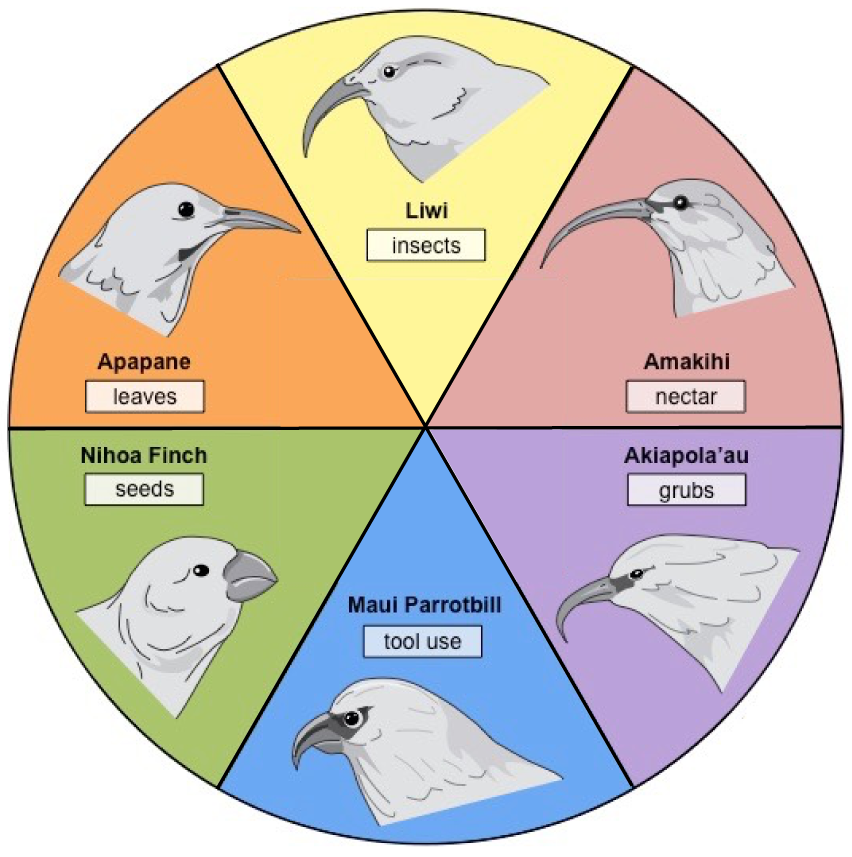
Modified from an image by the bioninja. Here’s a group of 18 Hawaiian moth species, all in the genus Hyposmocoma. Like the birds above, they’ve evolved into a wide variety of ecological niches, including aquatic species and predatory species.

(c) David Rubinoff. Used by permission of the author.
[qwiz qrecord_id=”sciencemusicvideosMeister1961-Evidence for evo: islands and biogeography”]
[h]Explaining the biology of remote oceanic islands.
[i]How do we explain the high diversity of endemic species on remote islands? How do we account for the lack of entire categories of animals?
[q labels = “top”]The reason why there are no terrestrial mammals, reptiles, amphibians, or freshwater fish on remote islands is because these types of animals have no way of ____________ these islands. The _________ surrounding these __________ makes ______________ by these kinds of animals impossible.
[l]colonization
[fx] No, that’s not correct. Please try again.
[f*] Correct!
[l]islands
[fx] No, that’s not correct. Please try again.
[f*] Correct!
[l]colonizing
[fx] No. Please try again.
[f*] Excellent!
[l]oceans
[fx] No. Please try again.
[f*] Excellent!
[q]Why do oceanic islands have so many _______, plants, and insects? Because while these volcanic islands might be geologically ________ compared to continents, they’re still __________ of years old. While colonization is __________, it does happen as small populations of birds, insects, or plant seeds get blown to these islands in _________, or simply fly off course.
[l]difficult
[fx] No, that’s not correct. Please try again.
[f*] Excellent!
[l]birds
[fx] No, that’s not correct. Please try again.
[f*] Good!
[l]millions
[fx] No. Please try again.
[f*] Excellent!
[l]storms
[fx] No, that’s not correct. Please try again.
[f*] Great!
[l]young
[fx] No, that’s not correct. Please try again.
[f*] Good!
[q]When they do arrive, they’re often the only examples of their kind on the island. This sets the stage for __________ ___________. Few ______________ species might serve as the original ___________. But over the subsequent years, each ancestor _______________ into many descendant species. That’s why remote oceanic islands are the home to so many ____________ species (species found only in that location).
[l]ancestral
[fx] No. Please try again.
[f*] Excellent!
[l]adaptive
[fx] No. Please try again.
[f*] Good!
[l]colonists
[fx] No, that’s not correct. Please try again.
[f*] Good!
[l]diversifies
[fx] No. Please try again.
[f*] Great!
[l]endemic
[fx] No. Please try again.
[f*] Good!
[l]radiation
[fx] No. Please try again.
[f*] Great!
[q]For the most part, land-living mammals can’t reach oceanic islands. But one type of mammal that can reach these islands. This is the the only flying mammal: the [hangman]. Also, not surprisingly, mammals that can [hangman], like seals, are also capable of colonizing oceanic islands.
[c]YmF0[Qq]
[c]c3dpbQ==[Qq]
[q]In terms of reptiles, most oceanic islands are completely free of native snakes and lizards. But the Galapagos islands have three species of iguanas. Their ancestors probably arrived through rafting on logs or mats of vegetation. Once on the Galapagos, one lineage into the marine iguana (shown below), the world’s only aquatic lizard.
[/qwiz]
5. Biogeography and Convergent Evolution: Checking Understanding
[qwiz qrecord_id=”sciencemusicvideosMeister1961-Evidence for Evo: biogeography and convergent evolution”]
[h]Biogeography and Convergent evolution (with a few questions about fossils)
[i]Biohaiku
An island’s fauna
So many birds and insects!
But no land mammals
[q]The study of the geographic distribution of species is called [hangman].
[c]YmlvZ2VvZ3JhcGh5[Qq]
[q]Species such as the euphorbs of Africa, Eurasia, and Australia and the cacti of the Americas are similar because of [hangman] evolution. Similar [hangman] pressures resulted in the evolution of similar [hangman] in each group.
[c]Y29udmVyZ2VudA==[Qq]
[c]c2VsZWN0aXZl[Qq]
[c]YWRhcHRhdGlvbnM=[Qq]
[q]The marsupials of Australia and the placentals of the Americas separately evolved into similar ecological [hangman]. While the marsupial mole of Australia and the Eastern mole of North America have similar [hangman] for a life spent burrowing through the soil, their phenotypic similarity is only superficial, a result of [hangman] evolution
[c]bmljaGVz[Qq]
[c]YWRhcHRhdGlvbnM=[Qq]
[c]Y29udmVyZ2VudA==[Qq]
[q]The euphorbs of Africa, Eurasia, and Australia and the cacti of the Americas aren’t particularly closely [hangman]. Their superficially similar adaptations weren’t inherited from a common [hangman]. The best way to describe them is as [hangman] traits.
[c]cmVsYXRlZA==[Qq]
[c]YW5jZXN0b3I=[Qq]
[c]YW5hbG9nb3Vz[Qq]
[q] [hangman] traits results from shared ancestry. There is a similar underlying structure, but the [hangman] might be different.
[c]IGhvbW9sb2dvdXM=[Qq]
[c]ZnVuY3Rpb24=[Qq]
[q][hangman] traits result from convergent evolution. The function of the part might be similar, but the underlying [hangman] is usually quite different. On the level of the entire organism, we can say that organisms are in a similar ecological [hangman], and therefore require a similar suite of adaptations.
[c]QW5hbG9nb3Vz[Qq]
[c]c3RydWN0dXJl[Qq]
[c]bmljaGU=[Qq]
[q]Many mysteries related to the distribution of fossil species (such as the one shown below) can be solved by the idea of [hangman] [hangman]
[c]Y29udGluZW50YWw=[Qq]
[c]ZHJpZnQ=[Qq]
[q]Oceanic islands, like the Galapagos Islands or the Hawaiian islands, are rich in endemic species. These species are [hangman] to a particular area, but found nowhere else.
[c]bmF0aXZl[Qq]
[q]The diversity of Hawaiian Honeycreepers can be explained through the concept of [hangman] [hangman]. All of these Honeycreepers, in other words share a common [hangman]. Over time, each species evolved to fill a different ecological [hangman].
[c]YWRhcHRpdmU=[Qq]
[c]cmFkaWF0aW9u[Qq]
[c]YW5jZXN0b3I=[Qq]
[c]bmljaGU=[Qq]
[q]One feature of island biology is that islands lack specific types of animals: amphibians, freshwater fish, land mammals, and reptiles. That’s because these types of animals are unable to cross the [hangman] that isolate these islands, and thus are never able to [hangman] the islands.
[c]b2NlYW5z[Qq]
[c]Y29sb25pemU=[Qq]
[/qwiz]
Links
- Developmental and Molecular Homologies (the next Evidence for Evolution tutorial)
- Evidence for Evolution Main Menu

